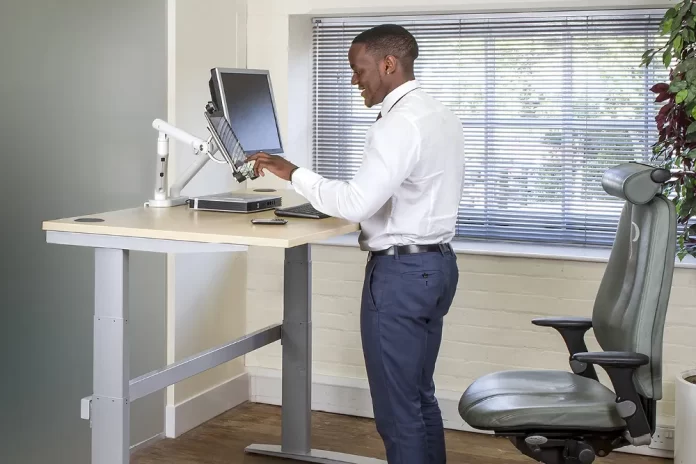Within the dynamic realm of Canadian workplaces, the unassuming desk is undergoing a technological metamorphosis, and the northern realms are witnessing the ascent of smart desks. With wireless connectivity and ergonomic innovations at the forefront, these advancements reshape how Canadians approach their workspaces. The once-static workstation is now a dynamic hub, responding to the evolving needs of the modern workforce.
In modern workplaces, a subtle yet profound transformation unfolds as the standing desk emerges as a focal point of technological innovation. The intersection of workplace dynamics and ergonomic design has given rise to a new era in office furniture headed by a standing desk. Delve into the nuanced landscape of standing desks to trace their evolution and impact on the modern Canadian work environment.
Table of Contents
Smart Desks: Revolutionizing the Canadian Office Space
In the busy landscape of workplaces, smart desks have emerged as a transformative force, combining cutting-edge technology with ergonomic design. They redefine the traditional office setup and integrate features that transcend mere functionality.
What Is a Smart Workstation?
Smart desks represent a paradigm shift in office furniture, incorporating technological advancements to enhance the user experience. Beyond the conventional, these desks boast a range of features:
- Wireless connectivity;
- Energy efficiency;
- Smart sensors that adapt to user behaviour.
This combination allows users to foster a dynamic and health-conscious workspace. Furthermore, the incorporation of advanced desk ergonomics directly addresses concerns related to posture and overall well-being, underscoring the significance of a holistic approach to workplace health.
Contrasting with traditional standing desks, smart desks surpass the limitations of static structures, offering a dynamic interface that adapts to the evolving needs of the modern Canadian workforce.
Technological Advancements in Smart Desk Design
Here are the intricate details of technological advancements, illustrating how these innovations are not mere additions but fundamental shifts that redefine efficiency, adaptability, and a forward-thinking ethos within the Canadian professional landscape:
- Cutting-edge desk technologies in Canada. Canadian manufacturers lead in integrating state-of-the-art technologies, transforming smart desks into sophisticated tools that significantly enhance workplace efficiency and functionality;
- Smart sensors for improved ergonomics. Explore the incorporation of smart sensors, a pivotal feature that not only tracks but enhances workplace ergonomics, offering a seamless and adaptable interface catering to diverse work styles and preferences;
- Energy-efficient standing desk designs. Examine the eco-conscious approach taken by Canadian manufacturers, evidenced in energy-efficient standing desk designs. This commitment aligns with Canada’s broader sustainability goals and environmental responsibility in the workplace.
Why Ergonomic Furniture Is Important in the Workplace?
In the realm of extensive desk work, the value of comfort cannot be overstated. Therefore, prioritizing ergonomic furniture is imperative for those concerned about their well-being. Here are the essential reasons why incorporating ergonomic furniture into your workspace is a prudent choice:
Enhancing Employee Well-Being
Ergonomic furniture, designed with the human body in mind, plays a crucial role in promoting employee health and well-being. From supportive chairs to adjustable desks, these elements reduce the risk of musculoskeletal disorders and enhance overall comfort during long work hours.
Boosting Productivity and Focus
A well-designed ergonomic workspace contributes to increased productivity and sustained focus. Comfortable seating and adjustable desks allow employees to maintain optimal postures, reducing fatigue and discomfort that may distract from the tasks at hand.
Preventing Workplace Injuries
Ergonomic furniture mitigates the risk of workplace injuries caused by prolonged poor posture. Adjustable chairs, desks, and computer monitors contribute to a workspace that aligns with the natural contours of the body, reducing strain on muscles and joints.
Adapting to Diverse Work Styles
Recognizing the diversity in work habits and preferences, ergonomic furniture offers flexibility. Adjustable chairs and desks accommodate different body types and working preferences, creating an inclusive environment that caters to the unique needs of each employee.
Reducing Absenteeism
By prioritizing employee health through ergonomic design, workplaces can potentially reduce absenteeism. A comfortable and supportive environment fosters a sense of well-being, contributing to a healthier and more engaged workforce.
Aligning with Health and Safety Regulations
Investing in ergonomic furniture demonstrates a commitment to compliance with health and safety regulations. This not only safeguards the well-being of employees but also ensures adherence to workplace standards set by regulatory bodies.
Improving Employee Morale
A well-designed and comfortable workspace fosters a positive and supportive atmosphere, improving overall employee morale. Employees feel valued when provided with ergonomic furniture, leading to increased job satisfaction and a more positive workplace culture.
Long-Term Cost Savings
While the initial investment in ergonomic furniture may seem substantial, the long-term benefits translate into cost savings. Reduced healthcare expenses, increased productivity, and lower turnover rates contribute to a positive return on investment over time.
The rise of smart desks and technological advancements in standing desk design marks a transformative era for offices. The fusion of technology, sustainability, and user-centric design positions these workstations as catalysts for a healthier and more productive workforce.
















